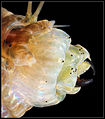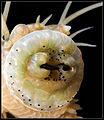- Alitta virens
-
Alitta virens 
Scientific classification Kingdom: Animalia Phylum: Annelida Class: Polychaeta Order: Aciculata Family: Nereididae Genus: Alitta Species: A. virens Binomial name Alitta virens
(M. Sars, 1835) [1]Synonyms[1] - Nereis virens M. Sars, 1835
- Neanthes virens (M. Sars, 1835)
- Nereis paucidentata Treadwell, 1939 *
- Nereis dyamushi Izuka, 1912 *
- Nereis grandis Stimpson, 1854 *
- Nereis southerni Abdel-Moez & Humphries, 1955 *
- Nereis yankiana Quatrefages, 1866 *
Alitta virens (common names include sandworm and king ragworm; older scientific names including Nereis virens are still frequently used) is an annelid worm that burrows in wet sand and mud. It is classified as a polychaete in the family Nereididae [1].
Sandworms make up a large part of the live sea-bait industry. "Sandworming", or the harvesting of sandworms from mudflats, employs over 1,000 people in Maine. As of 2006[update], the population of sandworms had diminished greatly over the preceding few years due in large part to overharvesting before the worms are able to reproduce by spawning.[citation needed]
Sandworms eat seaweed and microorganisms. They have many distinctive traits, including
- often reaching great length, sometimes exceeding four feet
- numerous, highly vascularized parapodia along both sides of their bodies
- blue heads with two large pincer teeth, said to occasionally bite humans[citation needed]
The parapodia function both as external gills (the animal's primary respiratory surfaces), and as means of locomotion (appearing much like short legs).[citation needed]
Gallery
References
- ^ a b c Kristian Fauchald & Chris Glasby (2009). "Alitta virens (M. Sars, 1835)". In Kristian Fauchald. World Polychaeta database. World Register of Marine Species. http://www.marinespecies.org/aphia.php?p=taxdetails&id=234851. Retrieved January 19, 2010.
* indicates a heterotypic synonym

This annelid-related article is a stub. You can help Wikipedia by expanding it.






